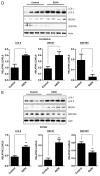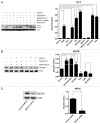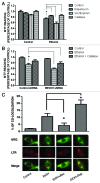Autophagy is a protective response to ethanol neurotoxicity
- PMID: 22874567
- PMCID: PMC3494588
- DOI: 10.4161/auto.21376
Autophagy is a protective response to ethanol neurotoxicity
Abstract
Ethanol is a neuroteratogen and neurodegeneration is the most devastating consequence of developmental exposure to ethanol. The mechanisms underlying ethanol-induced neurodegeneration are complex. Ethanol exposure produces reactive oxygen species (ROS) which cause oxidative stress in the brain. We hypothesized that ethanol would activate autophagy to alleviate oxidative stress and neurotoxicity. Our results indicated that ethanol increased the level of the autophagic marker Map1lc3-II (LC3-II) and upregulated LC3 puncta in SH-SY5Y neuroblastoma cells. It also enhanced the levels of LC3-II and BECN1 in the developing brain; meanwhile, ethanol reduced SQSTM1 (p62) levels. Bafilomycin A(1), an inhibitor of autophagosome and lysosome fusion, increased p62 levels in the presence of ethanol. Bafilomycin A(1) and rapamycin potentiated ethanol-increased LC3 lipidation, whereas wortmannin and a BECN1-specific shRNA inhibited ethanol-promoted LC3 lipidation. Ethanol increased mitophagy, which was also modulated by BECN1 shRNA and rapamycin. The evidence suggested that ethanol promoted autophagic flux. Activation of autophagy by rapamycin reduced ethanol-induced ROS generation and ameliorated ethanol-induced neuronal death in vitro and in the developing brain, whereas inhibition of autophagy by wortmannin and BECN1-specific shRNA potentiated ethanol-induced ROS production and exacerbated ethanol neurotoxicity. Furthermore, ethanol inhibited the MTOR pathway and downregulation of MTOR offered neuroprotection. Taken together, the results suggest that autophagy activation is a neuroprotective response to alleviate ethanol toxicity. Ethanol modulation of autophagic activity may be mediated by the MTOR pathway.
Keywords: alcohol; cerebellum; cerebral cortex; fetal alcohol spectrum disorders; mitophagy; neurodegeneration.
Figures









Similar articles
-
Activation of Autophagic Flux against Xenoestrogen Bisphenol-A-induced Hippocampal Neurodegeneration via AMP kinase (AMPK)/Mammalian Target of Rapamycin (mTOR) Pathways.J Biol Chem. 2015 Aug 21;290(34):21163-21184. doi: 10.1074/jbc.M115.648998. Epub 2015 Jul 2. J Biol Chem. 2015. Retraction in: J Biol Chem. 2020 Feb 28;295(9):2889. doi: 10.1074/jbc.W120.012895. PMID: 26139607 Free PMC article. Retracted.
-
Autophagy alleviates neurodegeneration caused by mild impairment of oxidative metabolism.J Neurochem. 2013 Sep;126(6):805-18. doi: 10.1111/jnc.12268. Epub 2013 Jun 9. J Neurochem. 2013. PMID: 23586593 Free PMC article.
-
Cocaine-mediated microglial activation involves the ER stress-autophagy axis.Autophagy. 2015;11(7):995-1009. doi: 10.1080/15548627.2015.1052205. Autophagy. 2015. PMID: 26043790 Free PMC article.
-
Autophagy and ethanol neurotoxicity.Autophagy. 2014;10(12):2099-108. doi: 10.4161/15548627.2014.981916. Autophagy. 2014. PMID: 25484085 Free PMC article. Review.
-
Promising and challenging phytochemicals targeting LC3 mediated autophagy signaling in cancer therapy.Immun Inflamm Dis. 2024 Oct;12(10):e70041. doi: 10.1002/iid3.70041. Immun Inflamm Dis. 2024. PMID: 39436197 Free PMC article. Review.
Cited by
-
Expression of autophagy and UPR genes in the developing brain during ethanol-sensitive and resistant periods.Metab Brain Dis. 2013 Dec;28(4):667-76. doi: 10.1007/s11011-013-9430-2. Epub 2013 Aug 27. Metab Brain Dis. 2013. PMID: 23979425 Free PMC article.
-
Endoplasmic Reticulum Stress and Ethanol Neurotoxicity.Biomolecules. 2015 Oct 14;5(4):2538-53. doi: 10.3390/biom5042538. Biomolecules. 2015. PMID: 26473940 Free PMC article. Review.
-
An overview of current advances in perinatal alcohol exposure and pathogenesis of fetal alcohol spectrum disorders.J Neurodev Disord. 2024 Apr 20;16(1):20. doi: 10.1186/s11689-024-09537-w. J Neurodev Disord. 2024. PMID: 38643092 Free PMC article. Review.
-
Rapamycin Improves Spatial Learning Deficits, Vulnerability to Alcohol Addiction and Altered Expression of the GluN2B Subunit of the NMDA Receptor in Adult Rats Exposed to Ethanol during the Neonatal Period.Biomolecules. 2021 Apr 28;11(5):650. doi: 10.3390/biom11050650. Biomolecules. 2021. PMID: 33924998 Free PMC article.
-
Autophagy impairment contributes to PBDE-47-induced developmental neurotoxicity and its relationship with apoptosis.Theranostics. 2019 Jun 9;9(15):4375-4390. doi: 10.7150/thno.33688. eCollection 2019. Theranostics. 2019. PMID: 31285767 Free PMC article.
References
-
- Riley EP, McGee CL. Fetal alcohol spectrum disorders: an overview with emphasis on changes in brain and behavior. Exp Biol Med (Maywood) 2005;230:357–65. - PubMed
-
- Yang C, Han LO. Knockdown of Beclin 1 inhibits vitamin K3‑induced autophagy, but promotes apoptosis of human hepatoma SMMC-7721 cells. Mol Med Report. 2010;3:801–7. - PubMed
-
- Chen Y, Gibson SB. Is mitochondrial generation of reactive oxygen species a trigger for autophagy? Autophagy. 2008;4:246–8. - PubMed
Publication types
MeSH terms
Substances
Grants and funding
LinkOut - more resources
Full Text Sources
Research Materials
Miscellaneous
